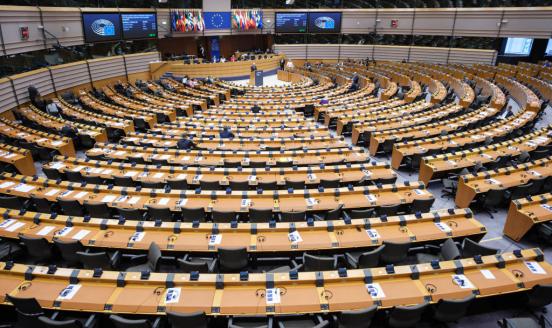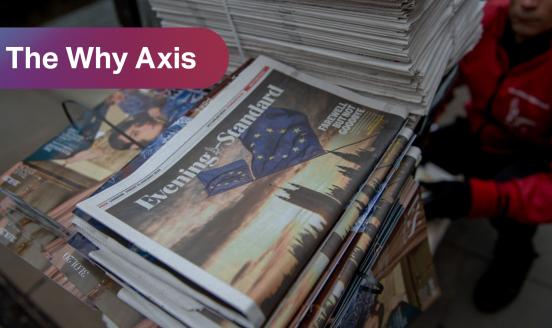EU savers need a single-market place to invest
Proposals to leverage the single market to boost retail investment could lead to a product citizens will trust

The European Union is sitting on €33.5 trillion in household savings
1
Eurostat; data as of end-2022. This total includes households and non-profit institutions serving households (NPISH). See https://ec.europa.eu/eurostat/statistics-explained/SEPDF/cache/57942.pdf.
, or one quarter of its collective GDP, yet much of this money is stuck in banks because households prefer cash over market investments. Meanwhile, former Italian Prime Minister Enrico Letta pointed to the EU’s fragmented capital markets as a big opportunity to spark growth and future investment in his report on the 27-country single market, published 17 April (Letta, 2024). He offered a menu of ideas to help the EU put its finances to work in the context of the need to find an extra trillion euros a year to fund the digital and green transitions and to meet defence needs. Managing climate change alone calls for finding 2.6 percent of GDP per year (I4CE, 2024).
Letta’s best idea, a new retail investment product that could be sold across the EU, could bring a single market for financial services much closer to reality than currently. To succeed, such an investment fund would need to be low-fee, highly diversified and available for sale across borders. Providers would need to commit to handling back-end tax filings on behalf of ordinary investors, who in turn should feel confident that any investment with an EU stamp would be easy to buy and sell, and unlikely to contain hidden pitfalls. Letta does not go into detail on what is needed but his endorsement, combined with an acknowledgment that previous efforts have been too unwieldy to succeed, may be the impetus needed to get such a project off the ground.
Letta’s capital markets recommendations reinforce recommendations from other stakeholders, including the Eurogroup, European Central Bank
2
See ‘Statement by the ECB Governing Council on advancing the Capital Markets Union’, 7 March 2024, https://www.ecb.europa.eu/press/pr/date/2024/html/ecb.pr240307~76c2ab27….
and various high-level expert groups. He posits incremental and feasible changes that could be put in place by 2026, even if in some cases he just calls for “progress” toward common supervision and other long-term goals. Only one recommendation misses the mark: the EU will not legally be able to consolidate all of its €1 trillion in outstanding institutional borrowing under a single debt management office, likely making it impossible to consolidate safe assets into a unified brand.
Letta proposes rebranding the long-stalled capital markets union (CMU) as a “savings and investment union,” a high-level choice that makes sense. The CMU project is now 10 years old and has mostly failed to deliver, in part because it was defined so broadly as to be impossible. A decade in, policymakers must set aside aspirations to fix insolvency, pensions, mortgages and taxes, because those areas touch on too many other EU member-state policies (Véron, 2024).
The most-promising option
That leaves three main levers that Brussels can pull from within the financial sphere: supervision, securitisation and retail investment. This last is the most promising and should be the main immediate focus. After all, common supervision has near universal support from the commentariat, including Letta, but remains blocked by EU governments. Countries are loath to give up national competence over asset managers, exchanges and other key market sectors, and nor does the European Securities and Markets Authority have the right structure to take all this on. Securitisation, on the other hand, is too technical to spark big changes in how society interacts with finance. Letta joins EU leaders and the ECB in calling for improvements where possible, yet he correctly shies away from creating an EU loan-bundling behemoth like US mortgage giants Fannie Mae and Freddie Mac, which required bailouts in 2008 and have been a rollercoaster for public finances.
Retail investing is approachable and offers huge potential. Data from Eurostat and the OECD shows that EU citizens face vastly different investment challenges simply based on where they live.
People in most EU countries keep most of their money in currency and deposits, followed by insurance policies and country-specific pension funds. On aggregate, EU households and household-related non-profits
3
Examples include churches, sports clubs and trade unions. For full definition, see https://ec.europa.eu/eurostat/statistics-explained/index.php?title=Glos…).
hold 34 percent of their assets in deposits and currency, compared to 14 percent in the US. The difference is also striking in absolute terms. US households hold in currency and deposits only 1.2 times (€14 trillion) the amount held by EU households, while total financial assets of households are over three times as large (€103 trillion).
The EU countries where households invest a relatively low share of assets in deposits and currency – Denmark, the Netherlands and Sweden – are also those with large mandatory funded pension systems. These countries are also those with household portfolios most similar to those in the US, which has the world’s deepest and most liquid financial markets.
Comparisons with the US are important because European firms too often see crossing the Atlantic as the only way to find necessary financing. While gross EU savings represent 25 percent of GDP, the EU’s market capitalisation is 81 percent of GDP. In the US, gross savings are only 18 percent of GDP, yet market capitalisation is a staggering 227 percent. The huge share of currency and deposits in EU household portfolios represents a large pool of capital that could be activated with the right products and policies.
The countries where savings look the most like the US are also those where savings are closest to approaching the same scale per capita, in purchasing-power parity terms, alongside wealth outlier Luxembourg. Economic disparities mean savers across the single market are living in very different circumstances.
A new approach
For an EU wide long-term investment product with auto-enrolment for interested savers to work best, policymakers should separate the question of automatic investment programs from the question of what, exactly, savers should invest in. Auto-enrolment is a useful strategy for encouraging pension participation, and it may be worth further attention. But a successful new investment product should be accessible inside or outside of a retirement-savings programme. It needs to be financially attractive on its own, regardless of whether and how countries offer tax incentives to set aside funds for the long term.
Letta points out that past initiatives such as the Pan-European Pension Product (PEPP) and European Long-Term Investment Fund (ELTIF) have suffered from limited uptake, and the EU’s heavily regulated UCITS funds (Undertakings for Collective Investment in Transferable Securities) have likewise seen outflows: $38 billion in 2023, on top of a $58 billion exodus in 2022
4
Nell Mackenzie, ‘UCITS $38 bln outflow shows investors pickier in higher rates era -Kepler Absolute Hedge’, Reuters, 6 February 2024, https://www.reuters.com/markets/europe/ucits-38-bln-outflow-shows-inves….
.
This is a market vacuum, and for once authorities can help: the EU should create an investment-fund standard that any large market provider can offer. It should have a clear and recognisable designation, for example an ‘EU Silver Star fund’ or similarly accessible label. This product could be offered locally, as suggested by the French Finance Ministry (2024), as long as it meets a rigorous set of pan-European standards and portability requirements.
As such a fund is designed, the EU can then direct national regulators to streamline its authorisation in each of the 27 national markets and to facilitate cross-border investment and portability. In exchange for all of these customers, the fund providers would commit to low fees and to handling withholding taxes for the various equities they invest in. This would address one of the biggest problems with today’s market: the tax at the source regimes that make it difficult for investors to earn profits without getting snarled up in years-long withholding tax refund procedures caused by fragmented tax regimes and antiquated processes.
Yes, today technically anyone who is sufficiently financially literate and with enough practical financial know-how can probably invest in capital markets from anywhere in the EU, and can even hire a company to custom-process their paperwork. But the data shows that most don’t. Instead, people buy the products offered by their local banks, which often have guaranteed but low returns and guaranteed high fees. Often, the only reason people buy these products at all is because of country-specific tax advantages for pension savings and similar goals. EU countries would do well to encourage an EU alternative, and if it works, to reallocate their tax benefits accordingly.
A widely adopted fund would give EU investors more access to the kinds of gains ordinary US savers have benefitted from for years. It would also introduce more people to capital markets and foster private saving. Portfolio managers could blend equities and similar assets into a broadly diversified fund similar to the S&P 500 Index. It should be allowed to invest globally, and authorities should resist the temptation to insist on limiting it to only European or even national industries. Authorities will want some safeguards to keep investment in Europe rather than making it too easy for it to go elsewhere, but they also need to prioritise the need of savers to tap into global potential. When savers do better, they have more trust in the system as well as more money to invest.
A good product will have market-driven reasons to invest part of its capital in Europe. Asset managers also could offer different fund options and risk profiles, such as a focus on large-cap or small-cap stocks, with fees adjusted accordingly. Even a higher-risk option that invests substantially in startups and SMEs could be part of the mix.
Letta hesitated when it came to letting retail investors go off the current beaten path. On the one hand, his 2026 roadmap calls for a new version of the ELTIF programme that would add tax incentives to generate more investor interest. On the other hand, he proposes an EU Deep Tech Stock Exchange limited to big asset managers and institutional investors
5
Letta (2024) defines ‘deep’ tech as “cutting-edge science and technology like Artificial Intelligence, Quantum technology or Biotechnology” (sic).
. His report identifies the problems that deep-tech startups, in fields like artificial intelligence and quantum computing, have in getting scale-up financing while staying in Europe, on top of the usual business risks that such ventures face.
There’s no inherent reason high-risk, high-return growth stakes need to be walled off completely from ordinary savers. If EU investors do benefit from a large, diversified investment fund to help their portfolios grow over time, they might also be able to take part in the deep-tech exchange under certain conditions, perhaps with a lower level of intermediation than current norms require. Jumpstarting EU capital markets would therefore ripple across the economy, from the most cutting-edge innovators to the most regional European saver.
After all, financial market integration is not an issue only for the financial industry, a point Letta makes very well. Financial markets finance the real economy, and at a time when shocks to that economy are becoming more frequent, in the context of changing geopolitical dynamics, it is more important than ever to reap scale and make capital allocation more efficient.
References:
DG Trésor (2024) Developing European capital markets to finance the future: Proposals for a Savings and Investment Union, Ministère de l'Économie, des Finances et de la Souveraineté industrielle et numérique, available at https://www.tresor.economie.gouv.fr/Articles/b3ffec15-7ff9-4d6e-a3e0-4b634958f898/files/6208f332-373b-4dc8-98f6-16cdad3e42ba
I4CE (2024) European Climate Investment Deficit Report, Institute for Climate Economics, available at https://www.i4ce.org/en/publication/european-climate-investment-deficit-report-investment-pathway-europe-future/
Letta, E. (2024) Much More Than a Market, report to the European Council, available at https://www.consilium.europa.eu/media/ny3j24sm/much-more-than-a-market-report-by-enrico-letta.pdf
Véron, N. (2024) ‘Capital Markets Union, Ten Years Later’, In-Depth Analysis, PE 747.839, requested by the ECON Committee, European Parliament, available at https://www.europarl.europa.eu/RegData/etudes/IDAN/2024/747839/IPOL_IDA(2024)747839_EN.pdf



